Module 3 Our School and Our Class Let’s Read
文档属性
| 名称 | Module 3 Our School and Our Class Let’s Read | 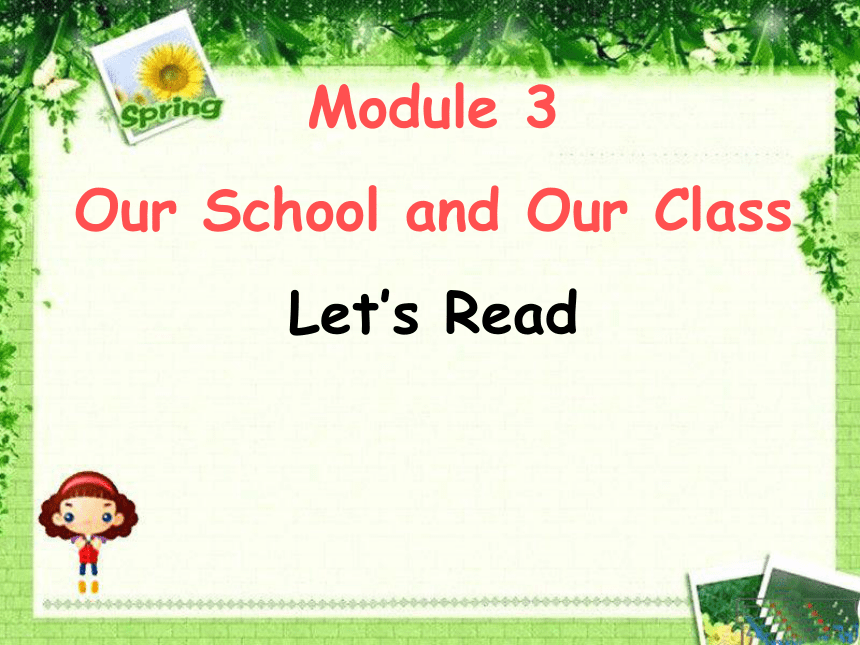 | |
| 格式 | zip | ||
| 文件大小 | 3.5MB | ||
| 资源类型 | 教案 | ||
| 版本资源 | 广州版 | ||
| 科目 | 英语 | ||
| 更新时间 | 2012-04-06 12:41:29 | ||
图片预览


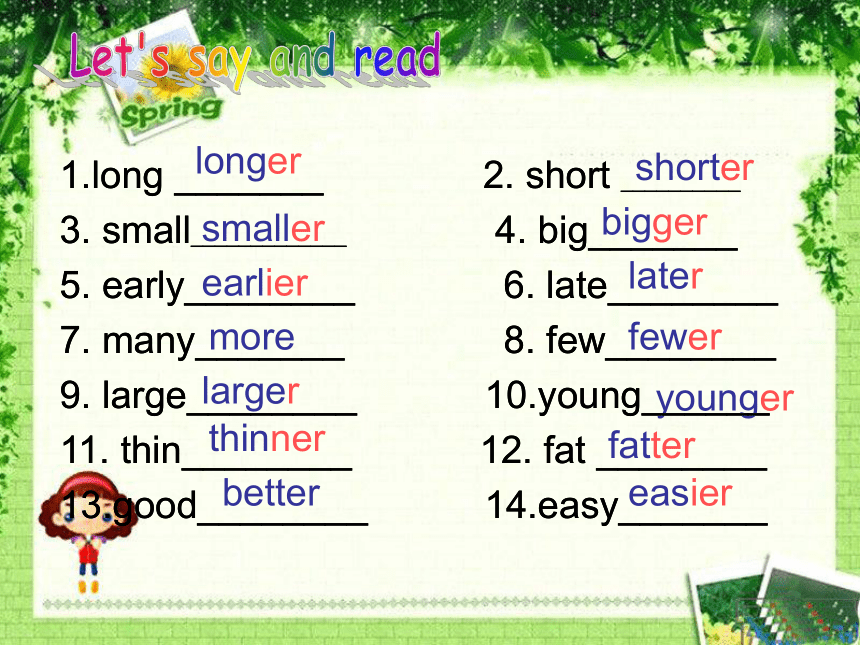
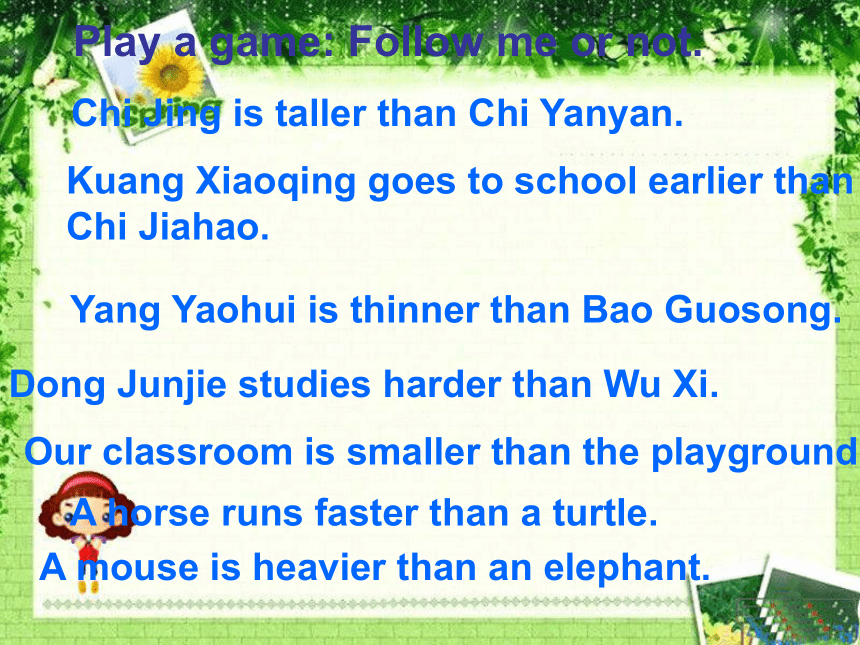
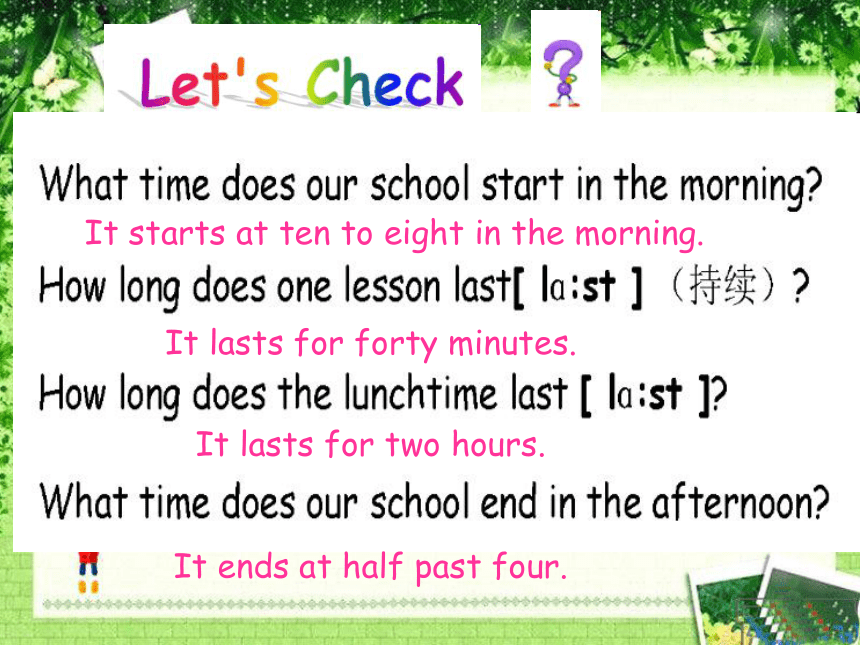
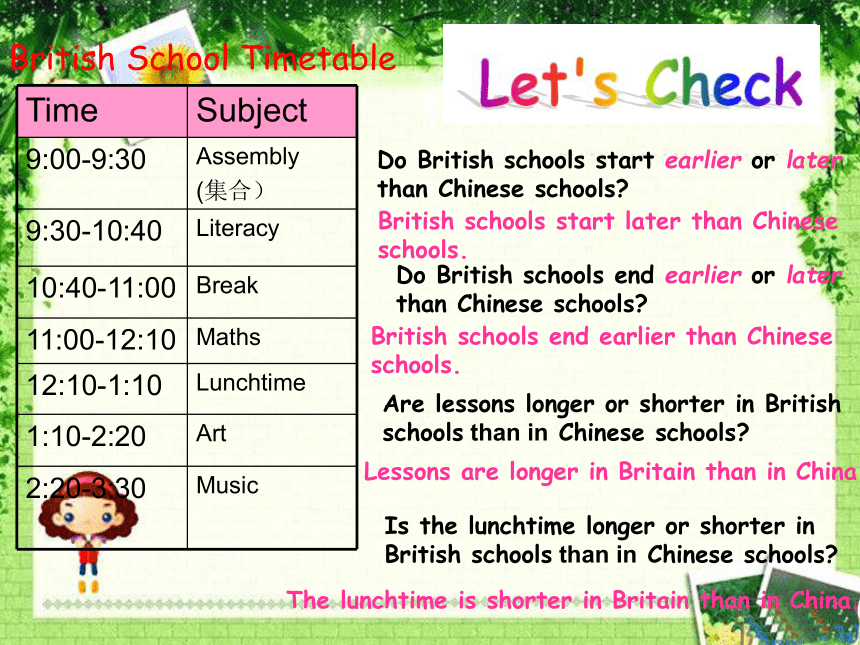
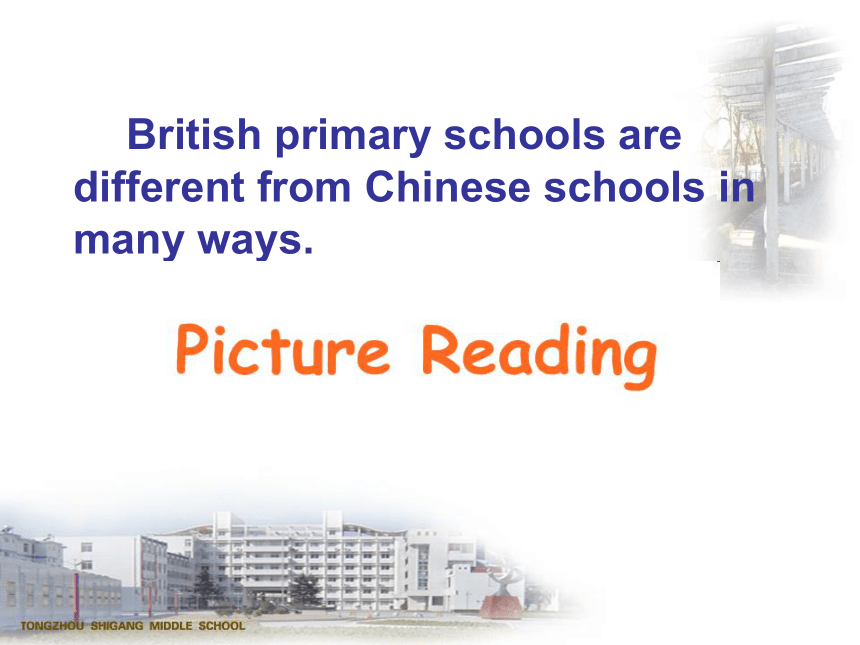
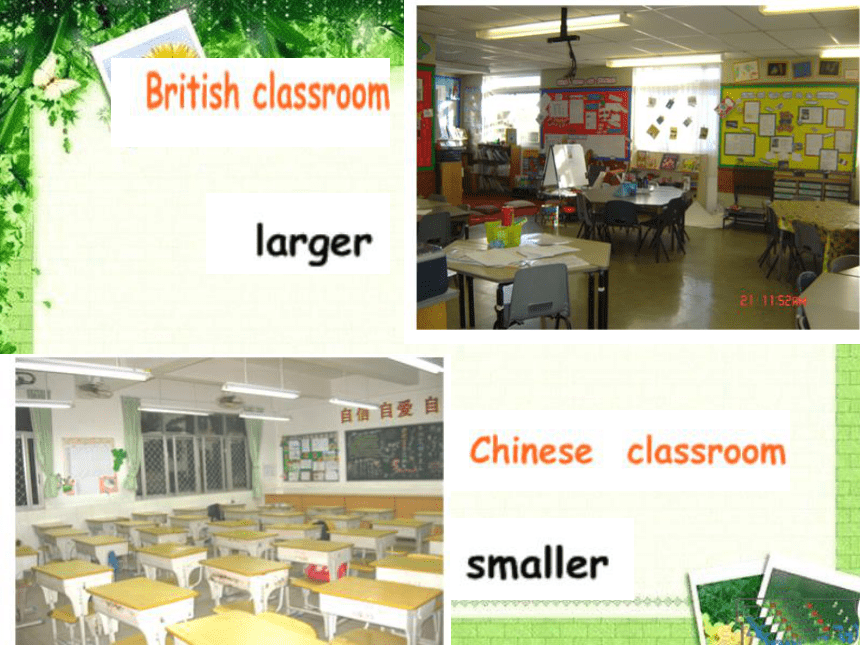
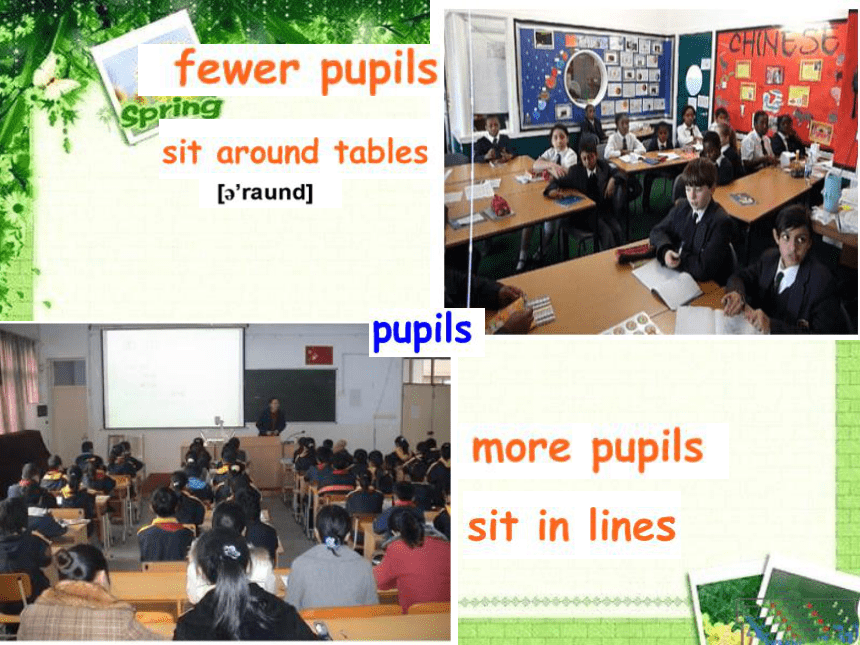
文档简介
(共23张PPT)
Module 3
Our School and Our Class
Let’s Read
long _______ 2. short __________
3. small_____________ 4. big_______
5. early________ 6. late________
7. many_______ 8. few________
9. large________ 10.young______
11. thin________ 12. fat ________
13.good________ 14.easy_______
longer
shorter
smaller
bigger
earlier
later
more
fewer
larger
younger
thinner
fatter
better
easier
long _______ 2. short __________
3. small_____________ 4. big_______
5. early________ 6. late________
7. many_______ 8. few________
9. large________ 10.young______
11. thin________ 12. fat ________
13.good________ 14.easy_______
Play a game: Follow me or not.
Chi Jing is taller than Chi Yanyan.
Kuang Xiaoqing goes to school earlier than Chi Jiahao.
Yang Yaohui is thinner than Bao Guosong.
Dong Junjie studies harder than Wu Xi.
Our classroom is smaller than the playground.
A horse runs faster than a turtle.
A mouse is heavier than an elephant.
It starts at ten to eight in the morning.
It lasts for forty minutes.
It lasts for two hours.
It ends at half past four.
Time Subject
9:00-9:30 Assembly
(集合)
9:30-10:40 Literacy
10:40-11:00 Break
11:00-12:10 Maths
12:10-1:10 Lunchtime
1:10-2:20 Art
2:20-3:30 Music
British School Timetable
Do British schools start earlier or later
than Chinese schools
Do British schools end earlier or later
than Chinese schools
Are lessons longer or shorter in British
schools than in Chinese schools
Is the lunchtime longer or shorter in
British schools than in Chinese schools
British schools start later than Chinese
schools.
British schools end earlier than Chinese
schools.
Lessons are longer in Britain than in China.
The lunchtime is shorter in Britain than in China.
British primary schools are different from Chinese schools in many ways.
划出形容词、副词比较级
British primary schools are different from Chinese schools in many ways. British schools are usually smaller with fewer(/’fju: /) pupils. But the classrooms in the UK are larger than Chinese ones. The tables are bigger too.
Unlike the pupils sitting in lines in China.
The British primary school students usually sit in groups around(/ ’raund/) tables. Younger pupils often sit on the floor in front of the blackboard to listen to their teacher. There are many shelves against the walls in the classrooms. There are also many storybooks on the shelves too. The classroom walls are usually colourful(/’kΛl f l/) with pictures and students’ work.
划出形容词、副词比较级
School starts later and ends earlier in the UK than in China, but lessons are longer, and there is only one break in the morning. The lunch break at noon is only one hour long, much shorter than in China, where the lunch break is two and a half hours long. Unlike in China, where different teachers teach different subjects, In the UK, the class teacher teaches all the subject.
Which do you think is better, a British primary school or a Chinese one
划出形容词、副词比较级
( )1.British schools have more pupils than Chinese schools.
( ) 2. The classrooms in the UK are larger than in China.
( ) 3. Chinese pupils usually sit in groups around tables.
( ) 4. School starts earlier and ends later in the UK.
( ) 5. In the UK, the class teacher teaches all the subjects.
F
T
F
F
T
British primary schools are different from Chinese schools in many ways. British schools are usually smaller with fewer(/’fju: /) pupils. But the classrooms in the UK are larger than Chinese ones. The tables are bigger too.
School starts later and ends earlier in the UK than in China, but lessons are longer, and there is only one break in the morning. The lunch break at noon is only one hour long, much shorter than in China, where the lunch break is two and a half hours long. Unlike in China, where different teachers teach different subjects, In the UK, the class teacher teaches all the subject.
B…-er than C.
There are -er… in B than in C.
The …in B is\are –er than in C.
C…-er than B.
There are -er… in C than in B.
The …in C is\are –er than in B.
Module 3
Our School and Our Class
Let’s Read
long _______ 2. short __________
3. small_____________ 4. big_______
5. early________ 6. late________
7. many_______ 8. few________
9. large________ 10.young______
11. thin________ 12. fat ________
13.good________ 14.easy_______
longer
shorter
smaller
bigger
earlier
later
more
fewer
larger
younger
thinner
fatter
better
easier
long _______ 2. short __________
3. small_____________ 4. big_______
5. early________ 6. late________
7. many_______ 8. few________
9. large________ 10.young______
11. thin________ 12. fat ________
13.good________ 14.easy_______
Play a game: Follow me or not.
Chi Jing is taller than Chi Yanyan.
Kuang Xiaoqing goes to school earlier than Chi Jiahao.
Yang Yaohui is thinner than Bao Guosong.
Dong Junjie studies harder than Wu Xi.
Our classroom is smaller than the playground.
A horse runs faster than a turtle.
A mouse is heavier than an elephant.
It starts at ten to eight in the morning.
It lasts for forty minutes.
It lasts for two hours.
It ends at half past four.
Time Subject
9:00-9:30 Assembly
(集合)
9:30-10:40 Literacy
10:40-11:00 Break
11:00-12:10 Maths
12:10-1:10 Lunchtime
1:10-2:20 Art
2:20-3:30 Music
British School Timetable
Do British schools start earlier or later
than Chinese schools
Do British schools end earlier or later
than Chinese schools
Are lessons longer or shorter in British
schools than in Chinese schools
Is the lunchtime longer or shorter in
British schools than in Chinese schools
British schools start later than Chinese
schools.
British schools end earlier than Chinese
schools.
Lessons are longer in Britain than in China.
The lunchtime is shorter in Britain than in China.
British primary schools are different from Chinese schools in many ways.
划出形容词、副词比较级
British primary schools are different from Chinese schools in many ways. British schools are usually smaller with fewer(/’fju: /) pupils. But the classrooms in the UK are larger than Chinese ones. The tables are bigger too.
Unlike the pupils sitting in lines in China.
The British primary school students usually sit in groups around(/ ’raund/) tables. Younger pupils often sit on the floor in front of the blackboard to listen to their teacher. There are many shelves against the walls in the classrooms. There are also many storybooks on the shelves too. The classroom walls are usually colourful(/’kΛl f l/) with pictures and students’ work.
划出形容词、副词比较级
School starts later and ends earlier in the UK than in China, but lessons are longer, and there is only one break in the morning. The lunch break at noon is only one hour long, much shorter than in China, where the lunch break is two and a half hours long. Unlike in China, where different teachers teach different subjects, In the UK, the class teacher teaches all the subject.
Which do you think is better, a British primary school or a Chinese one
划出形容词、副词比较级
( )1.British schools have more pupils than Chinese schools.
( ) 2. The classrooms in the UK are larger than in China.
( ) 3. Chinese pupils usually sit in groups around tables.
( ) 4. School starts earlier and ends later in the UK.
( ) 5. In the UK, the class teacher teaches all the subjects.
F
T
F
F
T
British primary schools are different from Chinese schools in many ways. British schools are usually smaller with fewer(/’fju: /) pupils. But the classrooms in the UK are larger than Chinese ones. The tables are bigger too.
School starts later and ends earlier in the UK than in China, but lessons are longer, and there is only one break in the morning. The lunch break at noon is only one hour long, much shorter than in China, where the lunch break is two and a half hours long. Unlike in China, where different teachers teach different subjects, In the UK, the class teacher teaches all the subject.
B…-er than C.
There are -er… in B than in C.
The …in B is\are –er than in C.
C…-er than B.
There are -er… in C than in B.
The …in C is\are –er than in B.
同课章节目录
- Module 1 Seasons
- Unit 1 What's your favourite season?
- Unit 2 It's the middle of winte
- Module 2 Plans
- Unit 3 We are going to have an English test
- Unit 4 Have a good time in Hainan
- Module 3 Invitations
- Unit 5 Would you like to go with us?
- Unit 6 See you at the party
- Module 4 Travel
- Unit 7 We will go by train
- Unit 8 Ben's first trip to Beijing
- Module 5 Safety
- Unit 9 Be careful!
- Unit 10 How to stay safe
- Module 6 Directions
- Unit 11 Can you tell me the way?
- Unit 12 I know a short cut
- Module 7 Let's look back
